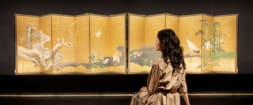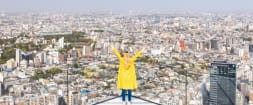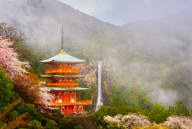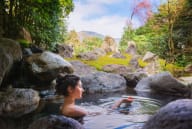
2023.03 Enjoy the Charms of Nobeoka; A City That is Celebrated for Ancient Noh Theater and Delicious Cuisine[PR] ©️NPO Nobeoka Tengaichi Citizen exchange Organization
Nobeoka is a convenient base for exploring Takachiho Gorge and the stunning landscapes of Miyazaki.
On the southeastern edge of Kyushu, Miyazaki Prefecture is known for its warm, sunny weather and beaches. Nobeoka City in Miyazaki is a former castle town with a long tradition of Noh theater. Visitors to Nobeoka will find rich traditions and food culture, along with unspoiled natural scenery where visitors can enjoy outdoor sports and seafood such as lobsters.
The city is close to Takachiho Gorge, which is well-known for its mystical scenery, and is also accessible from the popular hot springs area of Yufuin
An ancient castle wall forms a dramatic setting for traditional theater
Near the center of Nobeoka, the lush green Shiroyama Park was once the site of Nobeoka Castle, which was built in 1603. Although little remains of Nobeoka castle, a colossal stone wall indicates the castle’s former scale. This impressive 19-meter-high structure (approximately 20 yards) is called the "thousand-killer stone wall" because it was believed that if a keystone was removed from its foundation, the wall would collapse and crush a thousand enemies.



Once a year, the stone wall becomes a dramatic setting for Takigi Noh, a Noh performance held by firelight. Each October in Ninomaru Square in front of the stone wall, the Nobeoka Tengaichi Takigi Noh Theater performs a traditional song and dance drama. Masks are a key part of a Noh performance, and this is a rare opportunity to see masks that date back over 400 years. Nobeoka City has 72 carved wooden Noh masks which were given to the city by the Naito family, who ruled Nobeoka from the mid-18th to the end of the Edo period (1603–1867). Thirty of the masks were made by artists from the late 16th to late 17th century. These masks hold great cultural value, and the makers were declared to be “Tengaichi,” or “the best under the heavens" at the time.
On a single evening in October, bonfires are lit at dusk in front of the soaring stone wall, and the sounds of drums and flutes echo through the heavens. The highest-ranked performers in the world of Noh, wearing the rare Tenkaichi Noh masks, dance and perform in this one-night-only spectacle of ethereal beauty. It is one of Japan's most famous Noh performances by firelight.
In conjunction with the Takigi Noh Theater performance, the original Tenkaichi Noh masks are displayed at the Nobeoka Castle・Naito Memorial Museum located at the former site of Nishinomaru, a 7-minute walk from in Shiroyama Park. Replicas are displayed during the rest of the year, so this is a rare opportunity to see the real Noh masks. The masks have distinct facial expressions when viewed from different angles, which the skilled performers use to convey a range of emotions during the performance.
*In Japanese, Tenkaichi and Tengaichi means the same.











A bell keeping time for over 140 years
For generations, the toll of a bell has announced the time throughout the day. Six times a day, from 6 a.m. to 5 p.m., the bell has added a sense of rhythm and order to the day, from a bell tower at the ruins of the old castle tower in Shiroyama Park. Bell keepers have dutifully struck a large bronze bell at designated times every day since 1878. The current eighth-generation bell keepers are Yasuhiko and Mariko Hidaka, who say that they want to preserve a sense of the nostalgia of Japan in the sounding of the bell. Although you can hear the bell close to the bell tower, it is designed to reverberate through the area. Keep an ear out for the sound while gazing across the Gokase and Ose Rivers that sandwich Shiroyama Park. The deep sound of the bell punctuates the day, from early morning as the city wakes up, to the late afternoon as the sun slides behind the mountains. The current bell is the second generation, and its predecessor is on display at the Noboeka Castle・Naito Memorial Museum in order to preserve it.




A deity’s cave and relaxing hot springs
The mountainous northwest part of Nobeoka is called Kyushu's “last unexplored region”, due to its rugged terrain. While towering Mt. Okue (1,644 m) will challenge experienced climbers, Mt. Kamisan is a spiritual spot at the foot of Mt. Okue that is easy to explore. Climb the approximately 240 steps to the top of Mt. Kamisan, and you will be greeted by a mysterious natural feature. Two large rocks—one 24 meters high, the other 15 meters—support each other to form a cave. At the mouth of the cave is a straight-sided triangular rock, taller than a person. The ancient cave is believed to be the home of a deity and is marked by Shinto torii gates.
After visiting the cave, head to the Houri River Hot Spring, about 600 meters from the Mt. Kamisan trailhead. This slightly alkaline hot spring called Bijin no Yu, or “beauty hot springs” contains minerals that are said to smooth the skin. Soaking in the open-air bath while enjoying the breeze is a great way to relax after exploring Mt. Kamisan. On a clear day, you can even see the dramatic form of Mt. Okue from the bath.








A river of changing colors
A number of rivers flow through the city of Nobeoka. Among them is the Kogawa River, known as the "river of miracles" thanks to its crystal-clear water. The current is so gentle that even beginners can enjoy canoeing and SUP (stand up paddleboarding) tours. The beautiful river draws visitors for the water that changes color from blue to green to clear depending on the depth of the river. The water is so clear that you can see stones on the riverbed, schools of ayu (sweetfish) and koi (carp), swimming by as you paddle. Enjoy gliding down the river, which boasts one of the largest numbers of fish species in Japan. (Canoeing and SUP experiences are available from April or May to August. For details, please refer to the link at the end of this article.)




A treasure trove of food
Every end of October in Nobeoka City, an array of ayu fish traps, or ayu-yana, are set up to trap sweetfish on the Ose River, a tributary of the Gokase River, which flows from Takachiho Gorge. The "Nobeoka Suigo Ayu Yana," which is built over a river width of more than 100 meters (about 109 yards), is unparalleled in its grandeur. You can watch the ayu fall into the bamboo traps as they swim downstream, and savor grilled ayu dishes (seasoned with salt, miso, etc.) at the "Ayu Yana" restaurant. It is rare to see ayu-yana installed in urban areas, and they symbolize the purity of the water and abundance of nature.
Nobeoka has rich fishing grounds and abundant seafood. The fishing port in Kitaura, the northernmost part of the city, is on a beautiful rias coast facing the Hyuga Sea, and is famous for its lobster catches. The lobster fishing season runs from September to March, and draws visitors to enjoy sweet and tender Ise ebi (Japanese spiny lobster). From September to November, the area holds the Ise Ebi Festival along a road called the "Eastern Kyushu Ise Ebi Sea Line," which stretches all the way to Saiki City in Oita Prefecture. During the festival, delicious Ise ebi dishes are served at the restaurants along the road. The Himuka mackerel, which is bred with chemical-free farming methods, is another must-try. Try delicious mackerel sashimi with just the right amount of fat to enrich the flavor. You can also enjoy a wide variety of other seafood such as sea bream, horse mackerel, and greeneye, including assorted seafood-topped rice bowls.
While the seafood in Nobeoka is famous, there’s more to try. Spicy karamen is Nobeoka's soul food. It is a noodle dish with chopped chili peppers, garlic, chives, and ground meat, all topped off with an egg. The noodles, a mixture of both soba (buckwheat) and wheat flour, have a satisfying texture that is soft but firm. The level of spiciness can be selected according to preference.
Chicken Nanban, which originated in Nobeoka, is a dish of chicken tossed with flour and beaten egg, then deep-fried in oil. The delicious taste is unforgettable. Depending on the restaurant, it is served with either sweet vinaigrette or tartar sauce. Gyoza (dumplings) are also quite famous in Miyazaki prefecture for its unique culture of grilled gyoza the area, and are made with local ingredients including garlic, chives, and onions.











How to get there
Miyazaki Bougainvillea Airport provides convenient access to Nobeoka City. The airport is approximately 1 hour and 50 minutes by plane from Tokyo Haneda Airport, 2 hours and 10 minutes from Tokyo Narita Airport, and 1 hour and 10 minutes from Itami Airport or Kansai Airport in Osaka. Nobeoka is also accessible by train and car from all parts of Kyushu.
Access to Nobeoka
https://www.city.nobeoka.miyazaki.jp/site/nobeokaenglish/
Related Links
Nobeoka City |
|
WEB:https://www.city.nobeoka.miyazaki.jp/site/nobeokaenglish/ |
Nobeoka Tourist Association |
Outdoor Paradise Nobeoka |
(Youtube) Feel Fukuoka Japan |






























































